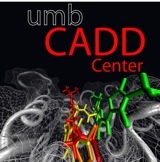Force Field Development
Back to Top
Quick Links:
CGenFF Utilization and Information
FFParam: Small-molecular parametrization GUI
Information on parameter optimization
Charge and polarizability perdiction for Drude FF
Least Squares Fitting
Dihedral Fitting
Chi1, chi2 QM data
Utilities for base stacking calculations
Additional tutorials and introductions to CHARMM
The following are some resources to facilitate the development of empirical force field parameters for use with the CHARMM36 biomolecular force field. For small organic molecules, we refer to the CHARMM General Force Field (CGenFF). The optimization of new parameters for CHARMM is not difficult, however, it does require careful reading of one of the parameter papers to understand the methodology. I suggest the supplemental information for the CHARMM 27 nucleic acid parameter paper, for which PDF versions are below. In addition, there is a tutorial available from a workshop that Dr. C. Brooks III and myself gave a couple years ago at the Pittsburgh Supercomputing Center along with a powerpoint presentation from the 2003 Sanibel conference that goes over creating a topology and obtaining parameters for a drug-like molecule. Links are provided below. The Pittsburgh site includes a collection of example CHARMM input files for parameter development.
Below are PDF files of the Supplemental Information from the CHARMM27 nucleic acids parameter optimization paper (Foloppe, N. and MacKerell, Jr., A.D. Journal of Computational Chemistry 21: 86-104, 2000. This represents the complete parameter paper, as in the published version the methods section is omitted (the best part...). Note that for the adjustment of the partial atomic charges it is important that the QM interactions with water be calculated at the HF/6-31G* level of theory to ensure compatibility with the current CHARMM force fields. For QM calculations to determine geometries, vibrations or conformational energies, use the highest level of theory possible.
jcc_21_86_2000_supp.PDF
jcc_21_86_2000_supp_fig.PDF
An overview of the parameter optimization approaches to extend the CHARMM force fields may be found at the CHARMM Links/Forum Link or from the following reference:
MacKerell, A.D., Jr. "Atomistic Models and Force Fields" in Computational Biochemistry and Biophysics, O.M. Becker, A.D. MacKerell, Jr., B. Roux and M. Watanabe, Eds., Marcel Dekker, Inc. New York, 2001, p. 7-38. See the following link: http://www.dekker.com/servlet/product/productid/0455-X
Charge and polarizabilites prediction tool for the Drude Force Field
Heid, E., Fleck, M., Chatterjee, P., Schröder, C., and , MacKerell, Jr., A.D. "Towards Prediction of Electrostatic Parameters for Force Fields that Explicitly Treat Electronic Polarization," Journal of Chemical Theory and Computation Submitted, 2019.
Download bash and python scripts to predict partial atomic charges and atomic polarizabilities for small molecules. Note that the current version of the predictor does NOT place partial charges on lone pairs as required by the Drude force field. Implementation of charges on the lone pairs is ongoing. Input for the prediction tool is the CGenFF toppar stream file of the molecule that contains both the topology and parameter information generated using the CGenFF program or with the PARAMCHEM server.
predict_pol_charge_1.0.tar.gz
|
The lsfitpar program for robust automatic fitting of bonded parameters
Dihedral Fitting Procedure
Guvench, O., MacKerell, Jr., A.D. "Automated conformational energy fitting for force-field developement," Journal of Molecular Modeling 14: 667-679, 2008.
Directory for dihedral fitting containing manuscript, input files, python script and readme files.
fit_dihedral.tar.gz
|
QM data for the dipeptide chi1 and chi2 dihedral angles:
Zhu, X. Lopes, P.E.M. Shim, J. and MacKerell, Jr. A.D. "Intrinsic Energy Landscapes of Amino Acid Side-Chains," Journal of Chemical Information and Modeling 52: 1559-1572, 2012.
sidechain_qm_chi1_chi2.tgz
|
Example scripts for determination of intermolecular orientation and generation of Z-matrices for QM optimization of stacked base monomers
McDonald, A.R. Denning, E.J. and MacKerell, Jr. A.D. "Impact of Geometry Optimization on Base-Base Stacking Interaction Energies in the Canonical A- and B-Forms of DNA," Journal of Physical Chemistry A 117: 1560-1568, 2013.
base_coordinate_reader.tgz
|
Additional tutorials and introductions to CHARMM
http://www.ch.embnet.org/MD_tutorial/
http://www.charmmtutorial.org/index.php/CHARMM_Tutorial
The CHARMM forum offers access to questions and answers to a wide variety of CHARMM related use and other issues. Please join the forum and use it as a resource to answer your questions; please check to previously posted questions before sending yours. It will save us a lot of time!
Additional sites to access CHARMM documentation and other information
http://brooks.chem.lsa.umich.edu/
http://master2.lobos.nih.gov/
http://yuri.harvard.edu
http://thallium.bsd.uchicago.edu/RouxLab/
|
Count and Map of Downloads
Map of Downloads
Count of Downloads
|
 |
|
